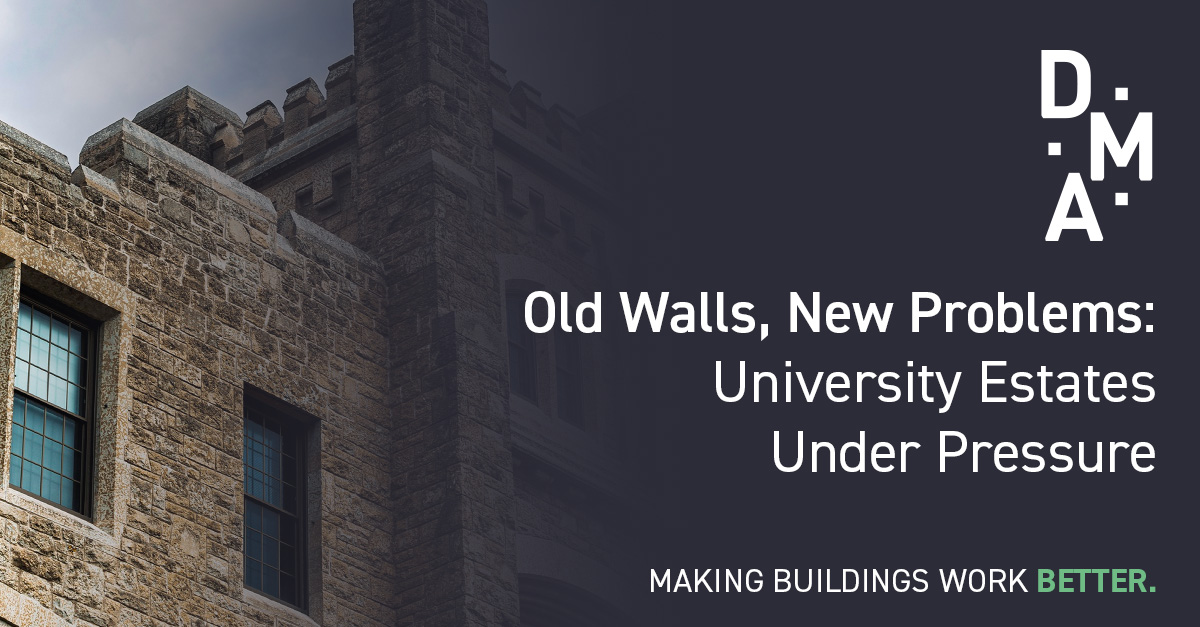
Old Walls, New Problems: University Estates Under Pressure
Across the UK’s public services, the condition of buildings is under increasing scrutiny—and universities are no exception. With ageing infrastructure, spiralling maintenance backlogs, and growing awareness of safety risks such as RAAC (reinforced autoclaved aerated concrete), investment in building maintenance is no longer optional—it’s essential. Recent data from the National Audit Office (NAO) and Freedom of Information (FOI) requests analysed by SFG20 and BDC Magazine highlight the scale and urgency of the challenge facing the UK’s higher education sector.
A Growing Backlog, and a Need for Action
According to the NAO, the total government maintenance backlog stands at a staggering £49 billion as of October 2024. This includes £13.8 billion attributed to schools and a further £13.8 billion to NHS properties—both of which share similar operational challenges to university estates. The report stresses that delayed maintenance can increase future costs by 1.5 times in just 2–4 years, making proactive investment both economically and operationally sound.
University Investment Trends: Who’s Leading the Way, and Why?
SFG20’s FOI-based research into 61 UK universities shows a notable disparity in maintenance spending, reflecting different estate profiles, financial strategies, and institutional priorities. Some universities, like Oxford, York, and Cambridge, stand out for both the scale and strategic nature of their investments.
But what drives these differences?
1. Size and Complexity of the Estate
Older and larger universities often operate vast, complex estates made up of historic buildings, specialist facilities, and high-use spaces. Maintaining everything from 15th-century colleges to state-of-the-art laboratories requires significant, ongoing investment.
- University of Cambridge, for example, has over 350 buildings spread across departments, colleges, and research facilities—explaining its £58.2 million investment in the most recent financial year. BDC Magazine, 2025.
Oxford similarly spans centuries of architectural styles and has a high density of listed buildings requiring specialist upkeep. They completed nearly 40,000 repair projects in the last financial year, spending £18.5 million—a strong performance under their budget cap of £26.4 million. SFG20, 2024.
2. Age and Heritage Significance
Many of the UK’s oldest universities—such as Durham, Edinburgh, and St Andrews—face unique maintenance challenges due to the age and heritage status of their buildings. Constructed from materials like sandstone and limestone, these structures are vulnerable to erosion, moisture damage, and biological decay. Retrofitting modern infrastructure, like IT networks or efficient heating systems, is often complicated by thick walls, outdated layouts, and the need to preserve architectural integrity.
Additionally, many of these buildings are listed, meaning even minor alterations require specialist materials and strict regulatory approval. Issues like dry rot, timber decay, or structural weaknesses may only be uncovered during intrusive surveys, leading to costly, unplanned repairs. Adapting such spaces for accessibility—adding lifts or step-free access—is another major challenge. But there are ways to help navigate these complexities.
Universities like Durham, St Andrews, and Edinburgh, with many pre-Victorian buildings, may face complex structural issues not present in modern campus designs.
3. Reputation and Student Experience
Top-tier universities understand the role facilities play in student satisfaction, recruitment, and global rankings. In a competitive education market, well-maintained campuses are a visual and functional reflection of institutional quality.
High international student numbers at institutions like Imperial College London or LSE place additional pressure on estate teams to meet expectations for cleanliness, safety, and technology infrastructure.
4. Proactive Risk Management
Some universities have adopted strategic, forward-thinking maintenance approaches—integrating Building Information Modelling (BIM), digital asset registers, and predictive maintenance systems. These institutions often show better cost control and fewer emergency repairs.
The University of York, for example, invested £12.8 million, and managed to come in £3 million under budget by aligning planned works with data-driven priorities. BDC Magazine, 2025.
In summary, maintenance spending isn’t just a number—it reflects a university’s physical footprint, heritage profile, institutional priorities, and strategic foresight. Those that invest wisely today are likely to save substantially tomorrow.
Why Building Maintenance Matters: Beyond the Bricks
While the conversation around university estates often focuses on flashy capital projects, it’s the less visible maintenance work that keeps campuses running safely and efficiently. Poor conditions can compromise student wellbeing, impact staff retention, and even halt academic operations. The NAO reports that between 2019–20 and 2023–24, an average of 5,400 clinical service incidents per year in the NHS were directly caused by infrastructure failures—offering a stark warning to all public service sectors, including education.
For universities, the stakes are just as high. The discovery of RAAC in some educational buildings has highlighted vulnerabilities, prompting institutions to rethink their estate strategies. Well-maintained buildings reduce the risk of emergencies, support positive student experiences, and align with net-zero goals by enabling energy-efficient upgrades.
Here’s a snapshot of how poor maintenance can impact different parts of university life:
Impact Area | Real-World Consequence |
Teaching & Learning | Lecture hall closures due to heating failure or ceiling leaks |
Student Experience | Negative reviews in National Student Survey (NSS) or online due to poor accomodation or inaccessible facilities |
Health & Safety | Fire alarm faults, unsafe stairwells, or RAAC-related evacuation incidents |
Energy Efficiency | Increased carbon footprint due to outdated HVAC systems or poor insulation |
Operational Continuity | Disruption to labs or IT services from water damage or power outages |
Reputation | Loss of competitive edge in recruitment due to visibly neglected infrastructure |
Strategic Maintenance: More Than a Quick Fix
Investment in maintenance isn’t just about fixing what’s broken—it’s about protecting the long-term value and performance of assets. The National Audit Office (NAO) has highlighted how government departments often default to short-term fixes because of budget constraints. But there’s a better way forward.
Institutions like Oxford and York have shown that by adopting a strategic approach to maintenance—planning ahead, prioritising based on risk, and integrating maintenance into capital decisions—they can deliver large volumes of work while staying under budget. This proves that long-term thinking works.
To support this shift, the government is encouraging public bodies to adopt long-term Strategic Asset Management Plans (SAMPs) and the use of consistent, high-quality estate data and evidence-based planning. The move away from reactive management towards proactive, science-led strategies underscores the importance of using data to guide decisions—ensuring that asset management not only makes financial sense but also accounts for long-term environmental and social impact.
For any organisation managing complex estates, aligning with this direction, by regularly surveying assets, managing risk, and planning for the future, means better performance, more sustainable operations, and improved resilience.
Conclusion
With a £49 billion maintenance backlog looming over public services and mounting pressure on higher education institutions to offer safe, sustainable environments, building maintenance is no longer a back-office issue. It’s central to institutional resilience and academic success.
As leading universities demonstrate, proactive investment in estate upkeep isn’t just smart—it’s necessary. From budget efficiency to safety assurance and environmental performance, the case for campus care has never been clearer.
National Audit Office (2025). Maintaining Public Service Facilities: Cross-Government Report. NAO report, January 2025
SFG20 (2024). UK Universities Investment in Building Maintenance. SFG20 blog
BDC Magazine (2025). Revealed: The UK Universities That Have Invested the Most in Building Maintenance. BDC article




